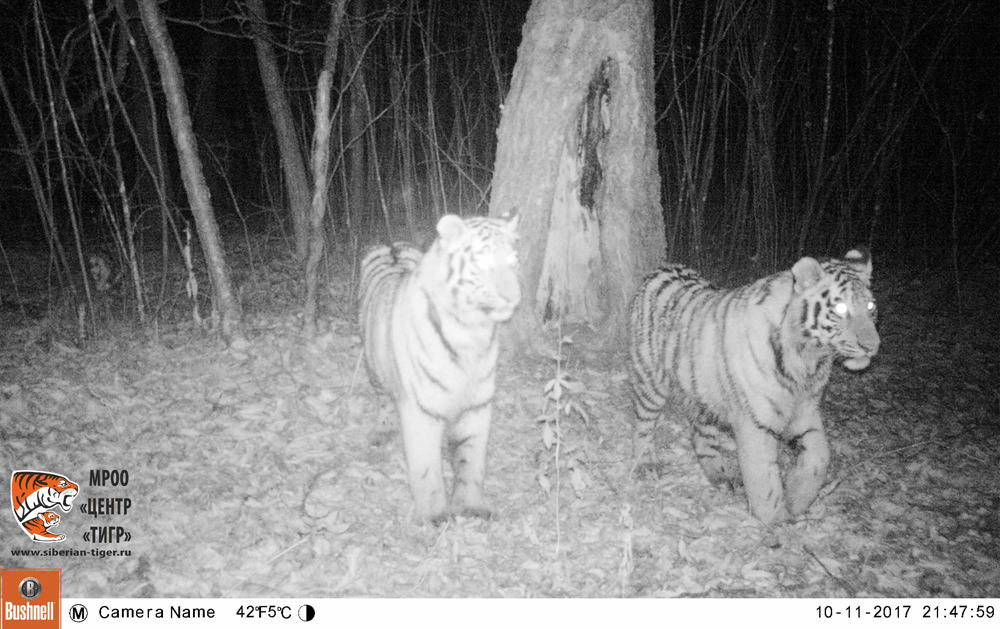At Last: Rehabilitated Tiger Reveals Her Wild Cubs
We knew that the once-orphaned Svetlaya had given birth to at least one cub. New images show there are three.
By Vicki Croke
Credit: Tiger Center, (Alekseevka Rehab Center), ANO Tigr, and the Wildlife Department of the Jewish Autonomous Region.
The last time we checked in on the Amur tiger Svetlaya—a resilient cat in the Russian Far East who had been rescued as an orphaned cub, rehabilitated, and released back into the wild—was this past summer.
The news even then was good: Trail camera images taken in the spring, and just collected, had shown that Svetlaya was raising at least one cub in the Zhuravlinii Wildlife Reserve. But details of her family life were scarce. In the picture, only the cub’s paws and shadow could be seen. And since these big cats can have several cubs at a time, those involved with the monitoring project wondered: Is it possible there are more?

In July, we saw this image of Svetlaya walking with one cub. (The cub is barely visible in this trail camera image.) Courtesy: WCS.
For months, and for understandable reasons, the mystery of Svetlaya’s cub count continued. The tiger’s terrain is rugged, and often unrelentingly cold and snowy, so for researchers, traveling to each camera trap station to retrieve images is difficult. In addition, according to Dr. Jonathan Slaght, the Russia and Northeast Asia Coordinator for the Wildlife Conservation Society, once the researchers get to camera traps there may be no footage of the mother tiger and young to view. “Tigers with young cubs commonly avoid their regular routes,” Slaght said in an email, “which are typically game trails, to avoid potentially-fatal encounters with things like bears, wolves, or other tigers while the cubs are young and vulnerable.”

Two of Svetlaya’s cubs.
But even with what we knew in July—that is, even with “just” one cub on the ground for Svetlaya—she counted as a successful pioneer: Svetlaya is one of a group of six tigers who graduated from a program that has over the past several years saved orphaned Amur tigers, treated them medically, put them through a safe training camp to learn to survive and hunt in the wild, and then released them into reserves. The chosen reserves had been empty of tigers for years, but were bolstered with better protections. And the hope was that these cats would multiply and over time fill the forests. Svetlaya became only the second such Amur tiger (they are also often called Siberian tigers) to do so. Zolushka, the half-starved tiger cub with the frostbitten tail, who was rescued in 2012 and grew up to thrive in the wild, and whom we’ve also reported on, was the first.
As of last week, we got the answer to the question of the cub count for Svetlaya. The latest images from conservationists have proven things are even better than originally thought: Svetlaya has been raising not just one healthy cub, but three.
We were alerted to the happy update by the multitalented Jon Slaght. Along with being a leading authority on the mysterious, massive, and endangered Blakiston’s fish owl, he’s involved in research projects on tigers and musk deer, and other Russian wildlife. He’s also an author, and a translator fluent in Russian. He had reposted the announcement made on Facebook by one of the Russian groups monitoring these cats—which include Tiger Center, (Alekseevka Rehab Center), ANO Tigr, and the Wildlife Department of the Jewish Autonomous Region. Dr. Slaght was kind enough to translate and even annotate the information for us. It reads in part:
“We knew as early as last spring that Svetlaya had given birth, but exactly how many cubs she had was a mystery. Svetlaya hadn’t really been seen on the camera traps set in Zhuravlinii Wildlife Reserve for about a year.”
The Russian conservationists report that the cubs are “about a year old now, happy, and healthy.” And that some of the images show the offspring mimicking their mother by sniffing at the scent on a tree. The gender of the cubs isn’t certain, though at almost a year, the images show that they are quite big. For most of us, it may be difficult to distinguish the cubs from one another, but experts can sort them by stripe pattern. And in regard to those stripes, an intriguing detail has surfaced. One of the cubs has a distinctive “stripeless patch” on his or her side—just like the father, Borya, who “has also been seen on recent camera trap images.” (Borya, by the way, had traveled about 200 miles from his own release site when he found Svetlaya in 2015.)

Father Borya’s stripes seem to be erased in one spot.
This past summer, Dale Miquelle, Director of WCS’s Russia Program, told us that Zolushka and her offspring live “in Bastak Reserve in NE Jewish Autonomous Region. Svetlaya lives in the Zhuravlinii Refuge, also in the same region, but about 75-100 km [47-62 miles] southwest, closer to the Chinese border.”
In this Pri-Amur region where Svetlaya’s and Zolushka’s reserves are, Russian conservationists report that there are now 11 tigers in residence in what had been tigerless forests. Almost all of them are either rehabilitated and released tigers, or their offspring who were born in the wild.
